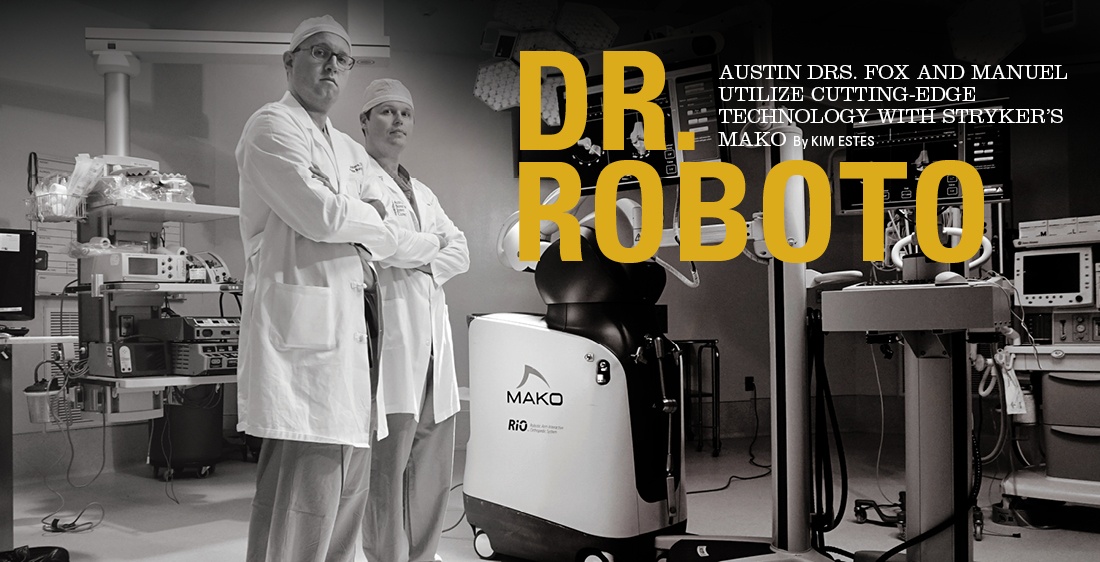Good news for parents worried their children play too many video games: two Austin orthopedic surgeons said this pastime taught them initial skills helpful to performing modern-day, robotic surgery.
Dr. Josh Fox and Dr. Jake Manuel laughed, but spoke with a note of seriousness saying that it was the video games they played as children that helped them adjust to using a robotic-arm for replacing knee and hip joints while watching the process on a screen. The procedure is called Mako. Notwithstanding their brief tribute to gamers everywhere, the two gave much applause to the surgically advanced technique used for partial knee and total hip replacement.
Mako, acquired by the Stryker Corporation in 2013, was developed by the MAKO Surgical Corporation using the Robotic-Arm Interactive Orthopedic System. It is a high-tech tool with a cool price tag of more than $1 million. Dr. Manuel and Dr. Fox said its real value is a more precise and accurate solution for patients suffering from knee or hip joint pain.
Dr. Manuel, with Austin Sports Medicine, said, “It takes an inexact operation and makes it precise. The robot maps out the bone and tells us how to cut. Only the affected bone and cartilage is removed due to the precision of the robot. No other tissue is damaged.”
“For partial knee replacement, I would not do it any way other than with Mako” -Dr. Josh Fox, with Austin Bone & Joint Clinic.

Some doctors, however, are uncomfortable with the advanced surgical methodology. Dr. Manuel said he understands their apprehension, but he maintains it is a procedure that truly benefits patients. “It is hard to get used to, but there was a study at Massachusetts General Hospital – Harvard – to determine how ‘good’ doctors are at the conventional style of partial knee replacement. We are ‘good’ only 50 percent of the time. The robot taught me I was not as good as I thought I was. It makes our effort better,” Dr. Manuel explained.
Most candidates for Mako have been diagnosed with osteoarthritis. It is the most common type of arthritis and found in about 27 million Americans age 25 and older, according to the National Institute of Arthritis and Musculoskeletal and Skin Diseases.
There are a few more specific conditions for which Mako is a treatment option. For partial knee replacement, the patient may have rheumatoid arthritis or avascular necrosis. “In total hip replacement, trauma rheumatoid arthritis, avascular necrosis or hip dysplasia would be a less common diagnosis,” Dr. Manuel said.
“With the 3-D model, you get more depth rather than just an up-and-down view”– Dr. Jake Manuel
For total hip replacement, Dr. Fox said, Mako is a particularly good solution in posterior procedures. “For a direct anterior (frontal) approach to hips, I typically have live x-ray present in the operating room and get that second sense of security that implants are exactly where I want them. For a posterior approach, however, it is difficult or impossible to use the live x-ray in the same way. These are the cases in which I am using Mako because it allows for that verification of implant position and, hopefully, improved longevity.”
“For partial knee replacement, I would not do it any way other than with Mako,” said Dr. Fox, with Austin Bone & Joint Clinic.
Additionally, the same study found Mako patients had increased post-operative function compared to those who underwent the manual procedure, based on American Knee Society Scores three months post-op. MAKOplasty.com reported that in initial outcomes of an ongoing study in partial knee replacement, the procedure resulted in more accurately placed implants and less pain for the first eight weeks after surgery compared with patients receiving manually placed implants. Dr. Fox cautioned, “Patients will have post-operative pain. We are still cutting bone. It will hurt, there will be swelling. I tell my patients that they are going to hate me for at least two weeks. But, in the end, they do well. We take out less bone with Mako, and that’s a big thing for partial knee replacement,” he said.
Dr. Manuel and Dr. Fox described a Mako partial knee replacement procedure from diagnosis through treatment.
“Degenerative changes are changes in the cartilage within the knee or any other joint,” Dr. Fox began. “Cartilage is a strong, smooth surface that caps the ends of bones. It is supposed to create a low-friction surface that allows bones to glide past each other with ease, allowing motion. As this cartilage ages or is injured, it can crack or peel, much like paint on a wall. As it peels off, it exposes the bone beneath. This leaves bone rubbing on bone in a joint, which is arthritis. Bone is not smooth and thus there is increased friction, and this increased friction leads to inflammation and ultimately to pain.”

The most helpful initial diagnostic tool in partial knee replacement is a standard x-ray. It gives an overall picture of the knee and where the cartilage is worn out or wearing thin. “If there is not clear evidence of the extent of the damage based on x-ray alone, then an MRI will give a detailed picture of the quality of cartilage throughout the knee,” Dr. Fox said.
Once the diagnosis is settled, for patients headed to surgery, a computed tomography, or CT, scan is scheduled for use in pre-operative planning. From the CT, the RIO creates a 3-D model that allows the surgeon to plan placement and alignment of the patient’s knee implants prior to surgery. Dr. Manuel said, “With the 3-D model, you get more depth rather than just an up-and-down view.”
In surgery, doctors guide the robotic arm while preparing the bone for the implant. “To resurface the knee, you essentially remove this layer [of cartilage] along with a small amount of the supporting bone, and replace it with a combination of metal and plastic to recreate the low-friction environment that is usually present within a joint,” Dr. Fox said.
“In the right patient, the success rate for Mako is very high”– Dr. Josh Fox
Real-time response from Mako ensures bone removal stays within “the safety zone” of the surgical plan, providing auditory, visual and tactile feedback, which stops the robotic-arm if necessary before bone can be removed outside the planned area. Dr. Fox said, “The robot will not allow you to push through to areas that are out of the plan, thus eliminating some potential bone loss. There is a haptic field that is setup in the process and, if the instrument leaves this field, the robot shuts down that instrument and will not allow the surgeon to proceed.”
Visually, there is a monitor on which physicians can watch changes they are making to the bone. “You can also look directly at the surgical site and compare the real knee to the virtual knee to verify that they match,” Dr. Fox said. Alarms beep if something out of the ordinary occurs, such as too much motion or too much pressure. “Additionally,” Dr. Fox said, “as the surgeon is getting started and registering the knee into the computer to match the pre-op CT scan, there are different sounds and tones as data points are collected to let him or her know if the points are good or not.”

Finally, through real-time capabilities the physician can see exactly where the tip of the instrument is at all times when in the surgical field. “It shows what bone has and has not been removed as compared to the surgical plan,” Dr. Fox said. “You can change the plan based on what you see at the time of surgery,” added Dr. Manuel.
Once bone preparation is complete, implants are placed in the knee. The procedure takes about 90 minutes. The patient can be completely asleep with general anesthesia, or sedated and treated with either spinal or epidural anesthesia.
Post-operatively, in most cases the patient is up and beginning therapy the day of surgery. “If it’s not the same day,” Dr. Fox said, “then it would be the next morning.” The time can vary before patients return to work. “I usually tell patients that they can return when they are physically able to do what they need to do for their jobs and their pain allows them to do so. For some people this is a week or less, and for some it can be longer,” Dr. Fox said.
Mako reports a failure rate nine times lower than manual surgery. Dr. Fox said, “In the right patient, the success rate for Mako is very high. It is a very effective tool for reducing or eliminating pain when it is applied to the right patient.” People experiencing knee pain that has failed to respond to non-surgical treatment or medication are advised to talk to their doctor.
For those interested in learning more about Mako, visit www.aboutstryker.com.
All Photos By Rudy Ximenez of RSX Studios.







Recent Comments